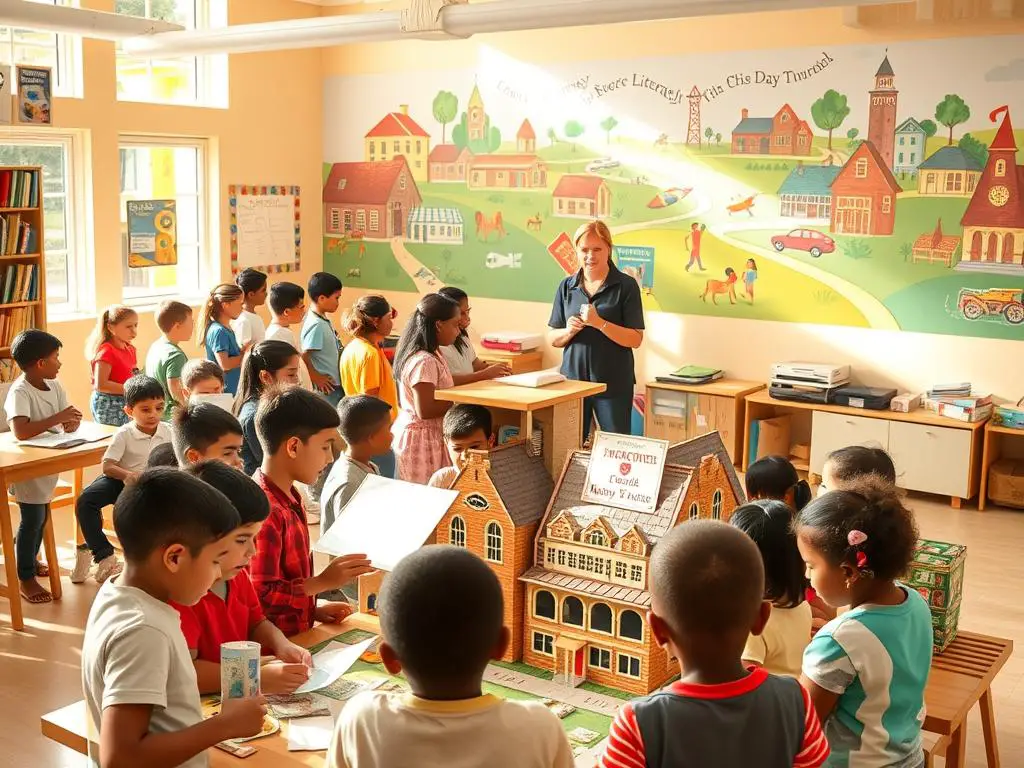Ever wondered why some adults are great with money while others struggle? It often comes down to their childhood. How they learned about money early on.
Early financial education shapes how kids see and manage money for life. When parents teach children money management early, they give them key skills. These lessons are more than just math.
Many parents wonder when to start talking about money. The truth is, it’s never too soon. Even little kids can learn about earning, saving, and spending.
Learning about money helps kids make better choices. They see that every buy has a cost and effect. This teaches them critical thinking that helps in many areas of life.
The best part? Teaching kids about money can be fun and natural. Simple daily tasks become chances to learn about money for life.
Key Takeaways
- Early financial education creates lasting positive habits and attitudes toward personal finances
- Age-appropriate lessons can begin as early as preschool years with simple concepts
- Financial responsibility develops critical thinking and decision-making skills beyond monetary matters
- Everyday activities provide natural opportunities for teaching valuable financial lessons
- Parents don’t need financial expertise to start meaningful conversations about spending and saving
- Connecting consequences to choices helps children understand the real-world impact of financial decisions
The Importance of Financial Education for Kids
Financial education is more than just math and saving money. Financial literacy for kids shapes their views on money and life. It helps them make smart choices and handle challenges.
Parents often ask when to start teaching about money. The truth is, kids learn from everyday experiences. Every grocery trip, allowance talk, and budget discussion teaches them about money.
Why Start Early?
Children’s brains are very flexible in their early years. Between ages 3 and 7, they learn about value and fairness. Starting early helps them develop good money habits.
Young kids are curious about money. They ask questions like “Why does this cost more?” and “How do we get money?” These questions are great chances to teach them about money.
Different ages need different money lessons:
- Ages 3-5: Basic counting, coin recognition, and simple value concepts
- Ages 6-8: Understanding earning through chores and basic saving goals
- Ages 9-12: Budgeting basics, comparing prices, and making spending choices
- Ages 13-15: Banking concepts, interest rates, and long-term planning
Long-Term Benefits of Money Management
Adults who learned about money early do better financially. They have higher credit scores and less financial stress. They also save more for retirement.
Learning about money early also helps in other areas. It improves problem-solving, decision-making, and math skills. These skills help in school and work.
Financially literate kids become resilient adults. They know the difference between needs and wants. They plan for the future and make smart choices.
Early financial education also helps avoid big mistakes later. Young adults who know about credit and investments avoid common errors. This sets them up for financial success and peace of mind.
Understanding Basic Financial Concepts
Teaching kids about money means breaking down big ideas into simple stories. Kids learn best when they can connect what they’re learning to their everyday life. Building a solid foundation in basic money concepts is key for their financial future.
Before learning about budgets and savings, kids need to grasp what money is. These basic ideas are the foundation for all future financial lessons.
What is Money?
Money is a universal trading tool that makes life easier than bartering. Imagine trading toys for groceries or homework for video games. It would get very complicated!
Explain to kids that money is agreed-upon value in society. When someone works, they get money for their time and effort. This money lets them buy things they need or want.
Think of money like arcade tickets. Just as tickets let you pick prizes, money lets you choose goods and services. The key difference is that money works everywhere, not just at one place.
Types of Currencies
Today, money comes in many forms that kids see every day. Knowing about these types helps them understand the world of payments.

- Physical cash – Bills and coins they can touch and count
- Debit cards – Electronic access to money in bank accounts
- Credit cards – Borrowed money that must be paid back later
- Digital payments – Apps and online systems for transferring money
- Gift cards – Prepaid money for specific stores or services
Each type works differently, but they all share the same basic idea. Money is money, whether it’s a dollar bill or a tap on a phone screen.
The Concept of Value
Value explains why things cost different amounts. A bicycle costs more than gum because it takes more materials and skill to make.
Supply and demand affects prices in ways kids can see. Popular toys cost more during holidays when everyone wants them. Ice cream trucks charge more at the beach because people want cold treats on hot days.
Help kids compare prices at their favorite stores. Why does name-brand cereal cost more than store-brand? It’s often because of marketing and packaging.
Teaching kids about value helps them become smart consumers. When they understand why things cost what they do, they make better spending choices.
Creating a Budget
Teaching kids to budget helps them make smart money choices. This skill changes how they think about spending and saving. Money management activities for children become more meaningful when they understand their money’s purpose.
A budget acts as a financial guide for kids. It teaches them to plan and make choices that match their goals. Budgeting shows kids they control their financial future.
Getting Started with Basic Budget Ideas
Explain that a budget is like a financial plan. Help your child list all their money sources, like allowances and jobs. This is their income.
Then, identify where their money goes. Kids often spend on toys, treats, and activities. Keep categories simple and relatable to their lives.
Use the 50-30-20 rule for kids: 50% for needs and wants, 30% for fun, and 20% for savings. This rule gives structure while allowing for age-appropriate choices.
Creative Methods to Monitor Spending
Make tracking expenses fun by turning it into a game. Use colorful charts where kids can mark each purchase. This makes tracking feel rewarding.
Try the envelope method with clear containers or decorated envelopes. Label each with spending categories. Kids can move money between containers, making concepts real.
Look into kid-friendly apps for tracking expenses. Many have games and colorful interfaces that kids enjoy. Always supervise app usage and ensure it’s suitable for their age.
Balancing Today’s Fun with Tomorrow’s Goals
Teach kids that spending and saving are both important. Explain that some purchases bring joy now, while saving is for bigger things later.
Introduce the “24-hour rule” for non-essential buys. Encourage kids to wait a day before buying something. This helps them decide if they really want it.
Use pictures or drawings to show savings goals. Seeing progress toward a goal motivates kids to stay on budget and builds patience.
The Value of Earning Money
When kids learn money comes from effort, they value it more. This link between work and reward builds habits that last a lifetime. It shows them money doesn’t just appear but needs effort and responsibility.
Parents can teach earning in many ways, fitting their family’s values. Some like structured systems, while others prefer flexible ones. The key is to be consistent and clear, so kids understand the effort-money link.
Chores and Allowances
The debate on allowances centers on whether they should be tied to chores or just for being part of the family. Chores-based allowances teach kids that work earns rewards. It shows them how the real world works.
Others give allowances just for being part of the family. This way, kids learn about money management without doing chores. They get to practice budgeting while doing their family duties.
Assigning chores based on age helps kids earn in meaningful ways. Young ones can sort laundry or feed pets. Older kids do more like cooking or yard work. Fair compensation depends on the task’s difficulty and time needed.

Beyond Allowances: Earning Money
There are many ways for kids to earn money beyond just allowances. They can offer services like pet sitting or watering gardens. These activities teach them about business and customer service.
Family projects also offer earning chances. Kids can help with garage sales, organize storage, or decorate for seasons. These efforts teach teamwork and help earn money.
Earning money for special occasions can be memorable. Kids can earn extra for holiday prep, helping with parties, or planning vacations. These experiences link earning to family traditions.
Sample Tasks for Kids
Assigning tasks based on age ensures kids face challenges they can handle and get fair pay:
- Ages 5-7: Making beds ($1), feeding pets ($2), sorting recycling ($1.50)
- Ages 8-10: Loading dishwasher ($3), vacuuming rooms ($4), organizing closets ($5)
- Ages 11-13: Meal preparation ($6), lawn mowing ($8), car washing ($7)
- Ages 14+: Babysitting siblings ($10/hour), tutoring younger kids ($12/hour), tech support ($15/task)
Pay should match local standards and your family’s budget. Regular checks ensure pay stays fair as kids grow. Gradual increases reward their progress and growing responsibilities.
Being reliable is key to earning more. Kids who do their tasks well earn trust and get more important jobs. This mirrors how people advance in their careers and teaches valuable money lessons.
Teaching Savings Techniques
Teaching kids to save money changes how they view money. When they learn to save, they feel more confident and excited. Effective savings strategies show them that money grows with patience and planning.
Children like to save in ways that are fun and easy to understand. Simple techniques are better than complicated ones that might confuse them.
What Are Savings Goals?
Savings goals give kids a reason to save. Goals can be for something small, like a toy, or something big, like a bike. Clear objectives keep them motivated when saving is hard.
Breaking down big goals into smaller steps makes saving easier. For example, saving for a $60 video game can be done by saving $10 each month for six months. This teaches patience and celebrates small wins.
Parents should help kids pick goals that fit their age and income. Younger kids might aim for smaller items, while older kids can dream bigger. Age-appropriate goals help avoid frustration and build confidence.
Setting Up a Savings Account
Opening a savings account introduces kids to banking early. Many banks offer special accounts for kids with no fees and low balances. Child-friendly accounts often include educational materials and fun features.
Visiting the bank regularly can be a learning experience. Parents can explain how banks work. Kids can see their money grow through interest, even if it’s small. This makes abstract concepts like interest more real.
Online banking for kids makes saving fun and interactive. These tools include games, trackers, and goal-setting features. Parents can keep an eye on accounts while kids learn to manage their money.
Using Piggy Banks Effectively
Piggy banks are still great for teaching kids about saving. Clear containers are better than opaque ones because kids can see their money grow. Visual progress motivates them to keep saving.
Using multiple containers helps kids save for different goals at once. One jar for toys, another for treats, and a third for long-term goals. This teaches them to prioritize and plan early.
Making deposits special encourages regular saving. Parents can make adding money to savings containers a special event. Celebrating progress makes saving feel rewarding, not restrictive.
Exploring Needs vs. Wants
Teaching kids about needs and wants is a key part of financial education. It helps them make smart choices with their money. When they understand this, they feel more confident in their spending decisions.
It’s important to teach this lesson patiently and with real-life examples. Kids often think they need things they see their friends with. It’s crucial to teach them to think before they buy.

Identifying Needs and Wants
Needs are things we must have to stay safe and healthy. This includes food, shelter, and clothes. Wants are things we like but don’t need, like toys and treats.
Play games to help kids sort items into needs and wants. For example, a coat is a need, but a fancy jacket is a want. This makes learning fun and interactive.
Use shopping trips to teach about needs and wants. Show them the difference between essential items and treats. It’s okay to want things, but we should think carefully before buying.
When kids feel pressured to buy something, talk to them about it. Explain how ads and friends can make us want things we don’t really need. This helps them make better choices.
Making Smart Spending Choices
Teach kids to wait before buying something they don’t need. This helps them decide if they really want it. Waiting can help them see if the desire is real.
Teach them to compare prices. This helps them make better choices and avoid overspending. Looking for the best value is a smart habit for life.
Explain opportunity cost in simple terms. Spending money on one thing means they can’t buy something else. Encourage them to think about which choice is better.
When kids make smart choices, praise them. This builds their confidence in managing money. It’s important to celebrate their successes.
Learning about needs and wants takes time. Kids will make mistakes, but that’s okay. Use these moments to teach them more about money. This wisdom will help them throughout their lives.
Introducing Investments and Interest
Teaching kids about money is a valuable lesson. They can learn about investments in simple ways. This knowledge helps them make smart money choices later on.
Think of investments like planting seeds. You put money in today, hoping it will grow later. Investments need time and patience to grow, just like plants need water and sunlight.
Investment Fundamentals
Start teaching kids about money with simple examples. Explain that investing means using money to buy something that might be worth more later. It’s like buying a bike that gets better with upgrades, or learning a skill that makes you more valuable.
Investing involves some risk, which means you might not always get back more than you put in. But, it also offers the chance for your money to grow more than it would in a piggy bank. Smart investors think about the long term and don’t expect instant results.
Use simple analogies to explain this. Training for sports makes you stronger over time. Reading books makes you smarter gradually. Good investments help your money grow slowly but surely.
How Interest Works
Interest is like a thank-you gift for letting someone use your money. When you lend money to a friend and they pay back a little extra, that extra is interest. Banks and companies do the same thing on a larger scale.
Compound interest is even more exciting. It’s when your money earns money, and then that new money earns money too. Imagine if every dollar you saved brought a friend, and then each friend brought another friend. Soon you’d have many more dollars than you started with.
To help children understand, use real numbers. If you save $10 and earn 5% interest, you’ll have $10.50 after one year. The next year, you earn interest on the full $10.50, not just the original $10. This creates a snowball effect that grows bigger over time.
Investment Examples for Kids
Real-life investment examples help when you teach kids about money management. A lemonade stand is a perfect first investment. You spend money on lemons, sugar, and cups, hoping to sell lemonade for more than your costs.
Parents might buy stocks, which are small pieces of companies. When companies do well and make money, the stock value often goes up. Bonds are like lending money to governments or companies, who pay you back with interest over time.
Even buying books or toys that hold their value can be investments. Some collectible items become worth more as they get older and harder to find. The key is choosing wisely and waiting patiently for the investment to grow.
Teaching these concepts early helps children develop patience and long-term thinking. They learn that the best financial rewards often come to those who plan ahead and make smart choices with their money.
The Role of Money in Society
Money moves through our communities like water in rivers, touching every part of our lives. When kids learn about money beyond their families, they gain financial literacy for kids that lasts a lifetime. This understanding helps them see why money matters so much.
Think about your neighborhood. Every store, school, and park exists because of money. When families spend money at local businesses, those businesses can pay their workers. Those workers then spend their paychecks at other stores, creating a cycle that keeps everyone working.

How Money Fuels the Economy
The economy works like a giant circle where everyone plays an important part. When your parents go to work, they earn money by helping their company succeed. That company sells products or services to other people, who pay with money they earned at their own jobs.
Your family’s grocery shopping helps keep the store running. The store pays its workers, who then shop at other businesses. This creates jobs for more people in your community. Financial literacy for kids includes understanding this connection between spending and jobs.
Taxes play a special role too. When families pay taxes, that money helps build schools, libraries, and parks that everyone can use. Fire departments, police, and road repairs all come from tax money. This shows children how their families contribute to shared community resources.
Local businesses depend on community support. When families choose to shop locally instead of only online, they help create jobs for their neighbors. This keeps money circulating in their own area, making the whole community stronger.
Careers That Involve Financial Literacy
Almost every job requires some money management skills. Financial literacy for kids opens doors to many exciting career paths. Bank workers help people save and borrow money safely. Accountants help businesses track their spending and earnings.
Restaurant owners must understand costs, prices, and profits to keep their businesses running. Doctors manage medical practice budgets while helping patients. Teachers handle classroom budgets for supplies and activities. Even artists need to price their work and manage their income.
Sports team managers work with player salaries and ticket sales. Store managers track inventory costs and sales profits. Construction workers often run their own businesses, requiring budgeting and pricing skills.
These careers show children that money skills help people succeed in any field they choose. Financial literacy for kids becomes a tool for achieving their dreams, no matter what those dreams might be.
Using Games to Teach Money Management
Games are a great way to teach kids about money. They offer a safe space for kids to learn about money without any real-world risks. This makes learning fun and exciting for them.
Playing fun ways to teach kids about money helps them develop important financial skills. It makes learning about money less stressful and more enjoyable. Plus, it’s a great way to bond with your family while learning.
Digital Tools and Interactive Apps
Today, technology offers amazing ways to teach kids about money. PiggyBot lets kids track their savings goals with fun visuals and rewards. It turns saving into a game where kids can earn new things.
iAllowance makes managing chores fun and educational. Kids see their money grow as they complete tasks. It teaches them about earning and budgeting in a real way.
Roblox has games that teach kids about money in a safe space. Kids can learn about business, budgeting, and investing without risk. It’s important for parents to watch screen time and join in on the learning.
Classic and Modern Board Game Options
Board games offer hands-on learning that digital tools can’t match. Monopoly teaches kids about managing properties, collecting rent, and making smart decisions. It introduces real-life money concepts in a fun way.
Payday simulates real-life money challenges. Players deal with unexpected costs, bills, and income. It teaches kids about the importance of saving and planning.
Games like The Allowance Game focus on money issues kids face. Players earn money, make spending choices, and learn about saving. These games mirror real-life money situations.
Money Bags Coin Value Game teaches kids about money and math. They learn to make change, count coins, and understand different money values. This lays the groundwork for more advanced money skills.
Talking about game decisions can deepen learning. Ask kids to explain their choices and explore other options. Extend lessons beyond game time by linking virtual scenarios to your family’s money experiences.
Think about tweaking games to fit your learning goals. Add savings challenges to games or create your own games that reflect your family’s money values.
Encouraging Entrepreneurship
Entrepreneurship turns abstract money ideas into real learning for kids. When they start their own businesses, they see how teaching children money management works in action. They learn that hard work and smart choices lead to financial gains.
Young entrepreneurs think critically and solve problems creatively. They feel proud when they make decisions and see the results. This makes learning about money fun and lasting for kids of all ages.

Business Ventures That Spark Interest
Business ideas for kids should match their interests and skills. Starting small helps them learn without feeling too much pressure.
Here are some great business ideas for young entrepreneurs:
- Lemonade stands – A classic first business teaching sales and customer service
- Pet-sitting services – Builds responsibility and earns money from neighbors
- Handmade crafts – Encourages creativity and understanding of costs
- Lawn care assistance – Teaches work ethic and seasonal planning
- Digital services – Creating birthday cards or simple websites for family friends
Choosing a business that kids are really interested in makes learning about money fun. Parents can help them find options that fit their family and community.
Understanding Business Mathematics
Learning about costs and profits teaches kids basic business concepts. Teaching children money management is more effective when they see real examples. These lessons prepare them for more complex financial decisions later.
Start with simple math that kids can understand:
- Material costs – Add up ingredients, supplies, or materials needed
- Time investment – Help kids value their work hours
- Overhead expenses – Include small costs like transportation or equipment
- Profit margins – Show how pricing above costs creates business income
Use visual aids and real examples from their business to explain these concepts. For example, if a lemonade stand costs $3 in supplies and sells $10 worth of drinks, the $7 profit shows good business planning.
Good customer service is key to success and repeat customers. Kids learn that happy customers become loyal supporters. This helps young entrepreneurs balance fair prices with excellent service.
Building Healthy Money Habits
Starting strong money habits means making financial care a regular part of life. It’s like brushing teeth or doing homework. This helps kids feel confident about handling money.
Make learning about money fun, not stressful. When money lessons for kids are enjoyable, they learn better. This approach keeps them interested in money for a long time.
Establishing a Routine for Money Management
Creating a money routine needs structure and creativity. Hold regular family money meetings to talk about goals and celebrate wins. These should be welcoming, not scary.
Weekly or monthly meetings work well for families. Use these times to check budgets and plan for the future. Make it interactive by letting kids share their spending choices.
- Review savings progress and celebrate milestones reached
- Discuss upcoming purchases or family financial decisions
- Play money-related games or complete financial challenges
- Share success stories and learn from spending mistakes
- Plan future savings goals and discuss strategies to achieve them
Being consistent is more important than being perfect. Even if you miss a meeting, get back to it soon. Patience and persistence help kids learn these skills slowly.
Make learning fun by rewarding good money habits. Treats or extra privileges for saving or spending wisely help create positive money associations.
Teaching About Credit
Learning about credit is key for adult money skills. Start with simple examples like borrowing lunch money. These everyday situations are great for teaching credit concepts.
Explain borrowing using examples they can understand. If your child wants to borrow money for a toy, talk about the terms. Will they pay it back from their allowance? How long do they have to repay it?
Introduce adult credit concepts in simple terms. Credit cards are like borrowing money from a bank, promising to pay it back later. Emphasize the importance of paying back on time and in full.
Explain credit scores in simple terms. A credit score is like a report card for paying back borrowed money. Good habits lead to better scores, while missed payments harm them.
Talk about the consequences of not paying back borrowed money. This includes higher interest rates and damaged relationships with lenders. Use examples they can understand, like how breaking promises affects friendships.
Consider these practical credit lessons:
- Always pay back borrowed money as promised
- Only borrow what you can afford to repay
- Understand the cost of borrowing money (interest)
- Keep track of what you owe and when payments are due
- Build trust by being reliable with borrowed money
Effective money lessons for kids need ongoing practice and support. These habits take time to develop but offer lasting benefits. Stay patient and supportive as your child learns these valuable skills.
Resources for Parents and Kids
Teaching kids about money is an ongoing task. Parents can find many resources to help with this at home.
Recommended Books for Financial Literacy
Books can make learning about money fun for kids. “Alexander, Who Used to Be Rich Last Sunday” by Judith Viorst helps young ones understand spending. For older kids, “The Kids’ Money Book” by Jamie Kyle McGillian covers earning, saving, and investing.
“Rock, Brock, and the Savings Shock” by Sheila Bair teaches compound interest in a fun way.
Online Courses and Workshops
Online platforms offer learning experiences for kids. Biz Kid$ has free videos on entrepreneurship and money. Practical Money Skills by Visa has games and lesson plans.
Jump$tart Coalition has curricula for different ages. These resources teach kids about money through fun multimedia.
Community Resources for Learning
Local groups offer hands-on money lessons. Banks have programs teaching kids about banking. Public libraries host workshops during summer reading.
Junior Achievement brings business experience into classrooms. 4-H clubs teach money management as part of their curriculum.
Using these resources, parents can give kids a strong financial foundation. This helps kids manage money well for their whole lives.
FAQ
At what age should I start teaching my child about money?
You can start teaching kids about money when they are 3-4 years old. At this age, they can learn about coins and how money buys things. By age 5-7, they can start learning about saving and making choices with money.
It’s important to teach money lessons that fit their age and developmental stage. As they get older, you can add more complex lessons.
How much allowance should I give my child?
There’s no one answer to how much allowance to give. A common rule is
FAQ
At what age should I start teaching my child about money?
You can start teaching kids about money when they are 3-4 years old. At this age, they can learn about coins and how money buys things. By age 5-7, they can start learning about saving and making choices with money.
It’s important to teach money lessons that fit their age and developmental stage. As they get older, you can add more complex lessons.
How much allowance should I give my child?
There’s no one answer to how much allowance to give. A common rule is $1-2 per week for each year of age. For example, a 7-year-old might get $7-14 a week.
What’s more important than the amount is being consistent. Use allowance to teach kids about budgeting, saving, and spending.
Should allowance be tied to chores or given unconditionally?
Both ways have their benefits. Tying allowance to chores teaches that money comes from work. Giving it without conditions teaches money management as a skill.
Many families use a mix of both. They give a base allowance for being part of the family and extra for doing more tasks.
What are some fun ways to teach kids about money without making it feel like a lecture?
Play board games like Monopoly to teach money. Use apps for kids’ financial education. Set up pretend stores at home.
Involve kids in real shopping decisions. Activities like treasure hunts for coins and running a lemonade stand are great too.
How do I explain the difference between needs and wants to my child?
Use examples from their daily life to teach about money. Needs are things like food and clothes. Wants are things like toys.
Practice categorizing items during shopping trips. Discuss why we prioritize needs first.
When should I open a savings account for my child?
Open a savings account when your child shows interest in saving, usually around 6-8 years old. It’s a great way to teach saving and banking.
Look for accounts with no fees and educational resources. Many banks have special programs for young savers.
How can I teach my child about investing in simple terms?
Start with the idea that investing means putting money into something that can grow. Use examples they can understand, like a lemonade stand.
Explain that investments have risks but can offer big rewards. This is different from just saving in a piggy bank.
What if my child wants to spend all their money immediately?
This is normal and a great chance to teach money lessons. Implement a waiting period rule before making big purchases.
Help them set savings goals for things they really want. Celebrate when they reach those goals. Use visual aids like savings jars to make progress exciting.
How do I handle money conversations during difficult financial times?
Be honest but age-appropriate about your financial situation. Focus on the positive steps your family is taking.
Involve children in money-saving activities. This teaches resilience and practical money skills. Emphasize that financial challenges are temporary and manageable.
What are some good entrepreneurship ideas for kids?
Age-appropriate business ideas include lemonade stands and pet-sitting. Selling handmade crafts and lawn care are also good options.
Choose activities that match your child’s interests and abilities. These experiences teach valuable lessons about money.
How can I make budgeting interesting for my child?
Make budgeting a game with colorful charts and stickers. Use the envelope method with real containers for different spending categories.
Let children help with budget decisions. Celebrate when they successfully manage their own small budgets. Make it visual and hands-on.
Should I give my child money for good grades or behavior?
While money rewards can be motivating, be careful not to make children expect payment for everything. Use money rewards sparingly for exceptional achievements.
Focus more on intrinsic motivation. Use money to teach financial responsibility, not as the main motivator for good behavior or grades.
-2 per week for each year of age. For example, a 7-year-old might get -14 a week.
What’s more important than the amount is being consistent. Use allowance to teach kids about budgeting, saving, and spending.
Should allowance be tied to chores or given unconditionally?
Both ways have their benefits. Tying allowance to chores teaches that money comes from work. Giving it without conditions teaches money management as a skill.
Many families use a mix of both. They give a base allowance for being part of the family and extra for doing more tasks.
What are some fun ways to teach kids about money without making it feel like a lecture?
Play board games like Monopoly to teach money. Use apps for kids’ financial education. Set up pretend stores at home.
Involve kids in real shopping decisions. Activities like treasure hunts for coins and running a lemonade stand are great too.
How do I explain the difference between needs and wants to my child?
Use examples from their daily life to teach about money. Needs are things like food and clothes. Wants are things like toys.
Practice categorizing items during shopping trips. Discuss why we prioritize needs first.
When should I open a savings account for my child?
Open a savings account when your child shows interest in saving, usually around 6-8 years old. It’s a great way to teach saving and banking.
Look for accounts with no fees and educational resources. Many banks have special programs for young savers.
How can I teach my child about investing in simple terms?
Start with the idea that investing means putting money into something that can grow. Use examples they can understand, like a lemonade stand.
Explain that investments have risks but can offer big rewards. This is different from just saving in a piggy bank.
What if my child wants to spend all their money immediately?
This is normal and a great chance to teach money lessons. Implement a waiting period rule before making big purchases.
Help them set savings goals for things they really want. Celebrate when they reach those goals. Use visual aids like savings jars to make progress exciting.
How do I handle money conversations during difficult financial times?
Be honest but age-appropriate about your financial situation. Focus on the positive steps your family is taking.
Involve children in money-saving activities. This teaches resilience and practical money skills. Emphasize that financial challenges are temporary and manageable.
What are some good entrepreneurship ideas for kids?
Age-appropriate business ideas include lemonade stands and pet-sitting. Selling handmade crafts and lawn care are also good options.
Choose activities that match your child’s interests and abilities. These experiences teach valuable lessons about money.
How can I make budgeting interesting for my child?
Make budgeting a game with colorful charts and stickers. Use the envelope method with real containers for different spending categories.
Let children help with budget decisions. Celebrate when they successfully manage their own small budgets. Make it visual and hands-on.
Should I give my child money for good grades or behavior?
While money rewards can be motivating, be careful not to make children expect payment for everything. Use money rewards sparingly for exceptional achievements.
Focus more on intrinsic motivation. Use money to teach financial responsibility, not as the main motivator for good behavior or grades.
